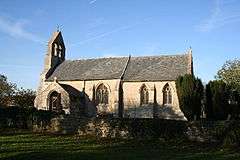Howell, Lincolnshire
Howell is a hamlet in the North Kesteven district of Lincolnshire, approximately 1 mile (1.6 km) north of the A17, 4 miles (6 km) east from Sleaford, and 1.5 miles (2.4 km) north from Heckington. It is in the civil parish of Asgarby and Howell.[1]
| Howell | |
|---|---|
 Church of St Oswald, Howell | |
 Howell Location within Lincolnshire | |
| OS grid reference | TF135463 |
| • London | 105 mi (169 km) S |
| Civil parish | |
| District | |
| Shire county | |
| Region | |
| Country | England |
| Sovereign state | United Kingdom |
| Post town | SLEAFORD |
| Postcode district | NG34 |
| Police | Lincolnshire |
| Fire | Lincolnshire |
| Ambulance | East Midlands |
| UK Parliament | |
History
In the Domesday account the village is written as "Hwelle". It consisted of 6 villagers, 14 freemen, 7 smallholders, land for 4 plough teams, a 32 acres (0.13 km2) meadow and a priest. In 1066 lordship of the manor of the manor of Sleaford was held by Barthi of Sleaford, being transferred to the Bishop of Lincoln, St Mary’s in 1086.[2][3]
Neolithic and Bronze Age finds and evidence of a Bronze Age round barrow have been found 1 mile to the north-east.[4][5][6][7] Less than 1 mile to the west of the village is the site of the lost village of Bacton or Boughton, mentioned in 1334, but only indicated by Medieval field patterns.[8]
In the village, just under the west face of the present Howell Hall, is evidence of Medieval settlement: rectilinear raised areas bounded by hollow ways that suggest toft or other buildings, and just further to the west, ridge and furrow field systems.[9]
Ditch earthworks indicate the possible position of the earlier Howell Hall (the extant is 19th-century) which define a non-moated structure with ornamental, wildfowling and fishing use. Later, the demolished Hall may have been used to construct village houses.[10]
Landmarks
Howell's Grade II* listed Anglican parish church is dedicated to St Oswald.[11] Originating in the 13th century, and restored in 1870, it includes a chancel, nave, a north aisle, chantry chapel, arcade of three bays, porch, and an Early English double bell-cote.[12][13]
The doorway to the south is Norman, described by Pevsner as "over-restored". In the chancel is an old altar slab with 5 crosses – that Pevsner believes is Anglo-Saxon – on the south side of which is a low sill serving for a sedilia, and on the north, double projecting almeries. The Decorated Gothic octagonal font, bearing Hebden, Rye, and Luttrell shields, was given to the church by Richard de Hebden (died 1373).[12][13]
In the chancel are several inscribed commemorative stones, the oldest of which is to Sir Nicholas de Hebden (died 1416), and his wife Katherine (died 1447). There also an incised slab and effigy to John Croxby, a 15th-century rector. In the chantry chapel is a 14th-century tomb with the busts of a lady and child, and a Jacobean monument to Sir Charles Dimok (or Dymok) of Howell, MP for the City of London (died 1602), and his wife Margaret (Butler). In the nave is a slab to Richard Boteler (died 1457), and his wife, Matilda (died 1456). In the east window of the north aisle is a Threckingham coat of arms.[12][13]
In the churchyard are the listed remains of a cross inscribed to the memory of John Spenser, rector, 1424-48.[12][13][14] Since Cox recorded the Spenser cross in 1916, the inscription has become undecipherable.[15]
The church, with those of Asgarby and South Kyme, is in the Heckington Group of churches.
Howell's two further listed buildings are a late 17th-century rectory, and early 18th-century Howell Hall.[16][17]
References
- "parish contact details".
- Howell in the Domesday Book. Retrieved 17 April 2012.
- "Documents Online: Howell, Lincolnshire", Folio: 356r, Great Domesday Book; The National Archives. Retrieved 17 April 2012
- Historic England. "Monument No. 892503". PastScape. Retrieved 17 April 2012.
- Historic England. "Monument No. 892508". PastScape. Retrieved 17 April 2012.
- Historic England. "Monument No. 892509". PastScape. Retrieved 17 April 2012.
- Historic England. "Monument No. 892510". PastScape. Retrieved 17 April 2012.
- Historic England. "Monument No. 351074". PastScape. Retrieved 17 April 2012.
- Historic England. "Monument No. 1434634". PastScape. Retrieved 17 April 2012.
- Historic England. "Howell Hall (351080)". PastScape. Retrieved 17 April 2012.
- Historic England. "Church of St Oswald, Asgarby And Howell (1061833)". National Heritage List for England. Retrieved 17 April 2012.
- Cox, J. Charles (1916) Lincolnshire pp. 173, 174; Methuen & Co. Ltd.
- Pevsner, Nikolaus; Harris, John; The Buildings of England: Lincolnshire p. 581; Penguin, (1964); revised by Nicholas Antram (1989), Yale University Press. ISBN 0300096208
- Historic England. "Churchyard Cross in the Churchyard of St Oswald's Church, Asgarby And Howell (1168431)". National Heritage List for England. Retrieved 17 April 2012.
- Historic England. "Monument No. 351077". PastScape. Retrieved 17 April 2012.
- Historic England. "The Old Rectory, Asgarby And Howell (1061834)". National Heritage List for England. Retrieved 17 April 2012.
- Historic England. "Howell Hall, Asgarby And Howell (1168460)". National Heritage List for England. Retrieved 17 April 2012.
External links

- "Howell", Genuki.org.uk. Retrieved 17 April 2012
- "Asgarby And Howell"; Roffe.co.uk. Retrieved 17 April 2012